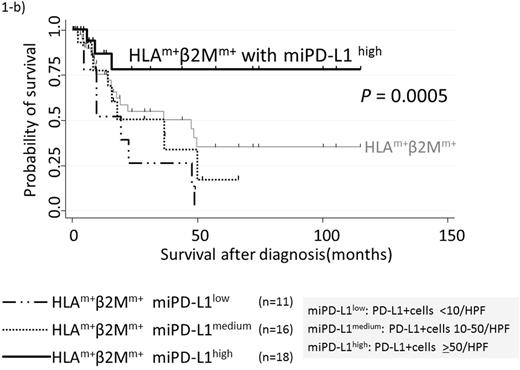Abstract
Introduction: Human T-cell lymphotropic virus (HTLV-1) carriers are often found in coastal areas of the Kyushu-Okinawa region in Japan. Of the patients infected with the virus, only 2-5% will develop adult T-cell leukemia/lymphoma (ATLL). ATLL is classified into four clinical subtypes as follows: acute, lymphoma, chronic, and smoldering. Chronic-type ATLL has a better prognosis compared with acute and lymphoma types. However, in half of patients, chronic-type ATLL progresses to leukemia/lymphoma crisis. Abnormal expressions of CD58 and beta-2 microglobulin (b2M) were recently reported to be involved in the immune escape mechanism of tumor cells in diffuse large B-cell lymphoma (Pasqualucci et. al. Cancer Cell 2014). In our previous study, acute-type ATLL had significantly higher rates of CD58 gene deletion, which was associated with leukemia/lymphoma crisis in chronic-type ATLL (Yoshida et. al. Cancer Res 2014). However, the clinicopathological significance of HLA expression in ATLL patients remains controversial. In addition, we previously reported that the expression of programmed cell death ligand 1 (PD-L1), one of the regulatory factors of tumor immune responses, influenced disease prognosis in ATLL patients. Especially PD-L1 expression in stromal cells in tumor microenvironments is associated with better prognosis of ATLL (Miyoshi et al. Blood 2016). The present study evaluated the clinical relevance of HLA, b2M, and PD-L1 expressions, with particular emphasis on predicting overall survival of ATLL patients.
Methods: We report the clinicopathological profiles of 123 patients diagnosed as having ATLL at Kurume University (Kurume, Japan) according to the 2008 World Health Organization classification system. Among these patients, 45 had the acute type and 52 had the lymphoma type, with a median age of 66 years (range, 13-90 years). We examined the immunohistological expressions of HLA and b2M proteins in all the 123 patients by using tissue microarray. The expression patterns and clinicopathological features were also examined statistically. All data were analyzed by using the STATA software version 12.0 (StataCorp, College Station, Texas).
Results: In the immunohistochemical study, 91 (74%) of the 123 patients were positive for HLA, including 60 who were cell membrane positive (HLAm+), 31 who demonstrated cytoplasmic localization (HLAcy+), and 32 who were negative for HLA (HLA−). In addition, 89 (72%) of the 123 patients were positive for b2M, including 54 who were cell membrane positive (b2Mm+), 35 who demonstrated cytoplasmic localization (b2Mcy+), and 34 who were b2M negative (b2M−). The HLAm+b2Mm+ group, which showed membrane staining for both HLA and b2M, accounted for 48 cases (39%) in the present study (Table 1). In terms of clinical features, no significant differences were found between the HLAm+b2Mm+ group and the other groups. Immunophenotypical evaluation revealed significantly higher rates of CD30-positive lymphoma cells (P = 0.004) and PD-L1-positive stromal cells in microenvironments (PD-L1+stromal cells ≥50/HPF: miPD-L1high) in the HLAm+b2Mm+ patients (P = 0.008) than in the patients in other groups. Disease-specific survival (DSS) curves showed that the HLAm+b2Mm+ group had significantly better prognosis than the other groups (Figure 1-a). Especially the HLAm+b2Mm+ group with miPD-L1high had an excellent prognosis, with a 5-year survival rate of 77% (Figure 1-b). The multivariate analysis demonstrated that the membrane expressions of both HLA and b2M in lymphoma cells with increased number of PD-L1-positive stromal cells were an independent factor of good prognosis in ATLL (Table2).
Conclusions: The results of our study demonstrated the following three points: 1) The expression patterns of HLA and b2M in the patients with ATLL varied. 2) The HLAm+b2Mm+ group showed significantly better prognosis than the other groups. Especially the HLAm+b2Mm+ group with miPD-L1high demonstrated the most favorable prognosis. These results suggest that the host immune surveillance mechanism for lymphoma cells in the HLAm+b2Mm+ group with mPD-L1high is still functioning. 3) The membrane expressions of HLA and b2M in ATLL cells are useful as a predictive marker of good prognosis and increase in the number of PD-L1-positive stromal cells in tumor microenvironments.
Asano:Chugai: Honoraria; Jannsen: Honoraria. Ohshima:Chugai: Research Funding, Speakers Bureau; Kyowa Kirin: Research Funding, Speakers Bureau.
Author notes
Asterisk with author names denotes non-ASH members.




This feature is available to Subscribers Only
Sign In or Create an Account Close Modal